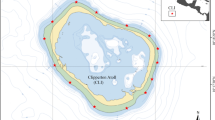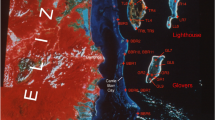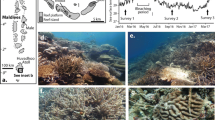Abstract
Dynamics in reef cover, mortality and recruitment success of a high-latitude coral community in South Africa were studied over 20 yr with the aim to detect the effects of climate change. Coral communities at this locality are the southernmost on the African continent, non-accretive, attain high biodiversity and are dominated by soft corals. Long-term monitoring within fixed transects on representative reef was initiated in 1993 and has entailed annual photo-quadrat surveys and hourly temperature logging. Although sea temperatures rose by 0.15 °C p.a. at the site up to 2000, they have subsequently been decreasing, and the overall trend based on monthly means has been a significant decrease of 0.03 °C p.a. Despite this, minor bleaching was encountered in the region during the 1998 El Niño–Southern Oscillation event, again in the summer of 2000/2001 and in 2005. A significant decreasing trend of 0.95% p.a. in soft coral cover has been evident throughout the monitoring period, attributable to significant decreases in Sinularia and Lobophytum spp. cover. In contrast, hard coral cover gradually and significantly increased up to 2005, this being largely attributable to increases in cover by Acropora spp. Recruitment success and mortality of both soft and hard corals has displayed high inter-annual variability with increasing but non-significant trends in the last 5 yr. The reduction in soft coral cover has been more consistent and greater than that of hard corals, but it is difficult at this stage to attribute this to changes in water quality, acidification-linked accretion or temperature.









Similar content being viewed by others
References
Akaike H (1974) A new look at the statistical model identification. IEEE Trans Automat Contr 19:716–723
Anderson MJ (2001) A new method for non-parametric multivariate analysis of variance. Austral Ecol 26:32–46
Anderson MJ (2006) Distance-based tests for homogeneity of multivariate dispersions. Biometrics 62:245–253
Anderson MJ, Gorley RN, Clarke KR (2008) PERMANOVA + for PRIMER: guide to software and statistical methods. PRIMER-E, Plymouth
Anderson RJ, McKune C, Bolton JJ, DeClerk O, Tronchin E (2005) Patterns in subtidal seaweed communities on coral-dominated reefs at Sodwana Bay on the KwaZulu-Natal coast, South Africa. Afr J Mar Sci 27:529–537
Arnold SN, Steneck RS, Mumby PJ (2010) Running the gauntlet: inhibitory effects of algal turfs on the processes of coral recruitment. Mar Ecol Prog Ser 414:91–105
Bak RPM, Nieuwland G (1995) Long-term change in coral communities along depth gradients over leeward reefs in the Netherlands Antilles. Bull Mar Sci 56:609–619
Bates D, Maechler M, Bolker B, Walker S (2014) lme4: linear mixed-effects models using Eigen and S4. R package version 1.1-6
Beger M, Sommer B, Harrison PL, Smith SDA, Pandolfi JM (2014) Conserving potential coral refuges at high latitudes. Divers Distrib 20:245–257
Box G, Jenkins G (1976) Time series analysis, forecasting and control. Holden Day, San Francisco
Box SJ, Mumby PJ (2007) Effect of macroalgal competition on growth and survival of juvenile Caribbean corals. Mar Ecol Prog Ser 342:139–149
Brown BE (1997) Coral bleaching: causes and consequences. Coral Reefs 16:S129–S138
Bray JR, Curtis JT (1957) An ordination of the upland forest community of southern Wisconsin. Ecol Monogr 27:325–349
Carpernter KE, Abrar M, Aeby G, Aronson RB, Banks S, Bruckner A, Chiriboga A, Cortés J, Delbeek JC, DeVantier L, Edgar GJ, Edwards AJ, Fenner D, Guzmán HM, Hoeksema BW, Hodgson G, Johan O, Licuanan WY, Livingstone SR, Lovell ER, Moore JA, Obura DO, Ochavillo D, Polidoro BA, Precht WF, Quibilan MC, Reboton C, Richards ZT, Rogers AD, Sanciangco J, Sheppard A, Sheppard C, Smith J, Stuart S, Turak E, Veron J, Wallace C, Weil E, Wood E (2008) One-third of reef-building corals face elevated extinction risk from climate change and local impacts. Science 321:560–563
Celliers L, Schleyer MH (2002) Coral bleaching on high latitude marginal reefs at Sodwana Bay, South Africa. Mar Pollut Bull 44:180–187
Celliers L, Schleyer MH (2008) Coral community structure and risk assessment of high-latitude coral communities at Sodwana Bay, South Africa. Biodivers Conserv 17:3097–3117
Connell JH, Hughes TP, Wallace CC (1997) A 30-year study of coral abundance, recruitment, and disturbance at several scales in space and time. Ecol Monogr 67:461–488
Cornish AS, DiDonato EM (2004) Resurvey of a reef flat in American Samoa after 85 years reveals devastation to a soft coral (Alcyonacea) community. Mar Pollut Bull 48:768–777
Crawley MJ (2013) The R book, 2nd edn. Wiley & Sons Ltd, United Kingdom
Darling ES, McClanahan TR, Côté IM (2013) Life histories predict coral community disassembly under multiple stressors. Glob Chang Biol 19:1930–1940
De’ath G, Lough JM, Fabricius KE (2009) Declining coral calcification on the Great Barrier Reef. Science 323:116–119
Development Core Team R (2015) R: a language for statistical computing. Foundation for Statistical Computing, Vienna
Doney SC, Fabry VJ, Feely RA, Kleypas JA (2009) Ocean acidification: the other CO2 problem. Annu Rev Mar Sci 1:169–192
Doropoulos C, Ward S, Diaz-Pulido G, Hoegh-Guldberg O, Mumby PJ (2012) Ocean acidification reduces coral recruitment by disrupting intimate larval–algal settlement interactions. Ecol Lett 15:338–346
Franklin H, Muhando CA, Lindah U (1998) Coral culturing and temporal recruitment patterns in Zanzibar, Tanzania. Ambio 27:651–655
Gabay Y, Benayahu Y, Fine M (2013) Does elevated pCO2 affect reef octocorals? Ecol Evol 3:465–473
Glassom D, Zakai D, Chadwick-Furman NE (2004) Coral recruitment: a spatio-temporal analysis along the coastline of Eilat, northern Red Sea. Mar Biol 144:641–651
Glassom D, Celliers L, Schleyer MH (2006) Coral recruitment patterns at Sodwana Bay, South Africa. Coral Reefs 25:485–492
Guinotte JM, Buddemeier RW, Kleypas JA (2003) Future coral reef habitat marginality: temporal and spatial effects of climate change in the Pacific basin. Coral Reefs 22:551–558
Harriott VJ, Banks SA (1995) Recruitment of scleractinian corals in the Solitary Islands Marine Reserve, a high latitude coral-dominated community in eastern Australia. Mar Ecol Prog Ser 123:155–161
Ho M-J, Dai C-F (2014) Coral recruitment of a subtropical coral community at Yenliao Bay, northern Taiwan. Zool Stud 54:5
Hoegh-Guldberg O (1999) Climate change, coral bleaching and the future of the world’s coral reefs. Mar Freshw Res 50:839–866
Hoegh-Guldberg O, Mumby PJ, Hooten AJ, Steneck RS, Greenfield P, Gomez E, Harvell CD, Sale PF, Edwards AJ, Caldeira K, Knowlton N, Eakin CM, Iglesias-Prieto R, Muthiga N, Bradbury RH, Dubi A, Hatziolos ME (2007) Coral reefs under rapid climate change and ocean acidification. Science 318:1737–1742
Huggett JA (2014) Mesoscale distribution and community composition of zooplankton in the Mozambique Channel. Deep Sea Res Part 2 Top Stud Oceanogr 100:119–135
Hughes TP, Connell JH (1999) Multiple stressors on coral reefs: a long-term perspective. Limnol Oceanogr 44:932–940
Humphries MS (2013) DDT residue contamination in sediments from Lake Sibaya in northern KwaZulu-Natal, South Africa: implications for conservation in a World Heritage Site. Chemosphere 93:1494–1499
Humphries MS, Benitez-Nelson CR (2013) Recent trends in sediment and nutrient accumulation rates in coastal, freshwater Lake Sibaya, South Africa. Mar Freshw Res 64:1087–1099
Hyndman RJ, Khandakar Y (2008) Automatic time series forecasting: the forecast package for R. J Stat Softw 27:1–22
Inoue S, Kayanne H, Yamamoto S, Kurihara H (2013) Spatial community shift from hard to soft corals in acidified water. Nat Clim Chang 3:683–687
IPCC (2007) Intergovernmental Panel on Climate Change. Physical science basis. Summary for policymakers, IPCC Secretariat
ISRS (2004) The effects of terrestrial runoff of sediments, nutrients and other pollutants on coral reefs. Briefing Paper 3, International Society for Reef Studies, 18 pp
Kendall M, Stuart A (1983) The advanced theory of statistics, vol 3. Macmillan Publishing, London UK
Kruskal JB, Wish M (1978) Multidimensional scaling. Sage Publications, Beverley Hills
Ljung GM, Box GEP (1978) On a measure of lack of fit in time series models. Biometrika 65:297–303
McClanahan TR (2014) Decadal coral community reassembly on an African fringing reef. Coral Reefs 33:939–950
Mills SC, Beldade R, Chabanet P, Bigot L, O’Donnell JL, Bernardi G (2015) Ghosts of thermal past: reef fish exposed to historic high temperatures have heightened stress response to further stressors. Coral Reefs 34:1255–1260
Muir PR, Wallace CC, Done T, Aguirre JD (2015) Limited scope for latitudinal extension of reef corals. Science 348:1135–1138
Porter SN, Branch GM, Sink KJ (2013) Biogeographic patterns on shallow subtidal reefs in the western Indian Ocean. Mar Biol 160:1271–1283
Pfeiffer M, Dullo W-C (2006) Monsoon-induced cooling of the western equatorial Indian Ocean as recorded in coral oxygen isotope records from the Seychelles covering the period of 1840–1994 AD. Quat Sci Rev 25:993–1009
Quéré CL, Rödenbeck C, Buitenhuis ET, Conway TJ, Langenfields R, Gomez A, Labuschagne C, Ramonet M, Nakazawa T, Metzl N, Heimann M (2007) Saturation of the Southern Ocean CO2 sink due to recent climate change. Science 316:1735–1737
Raymundo LJ, Maypa AP (2003) Getting bigger faster: mediation of size-specific mortality via fusion in juvenile coral transplants. Ecol Appl 14:281–295
Reynolds RW, Rayner NA, Smith TM, Stokes DC, Wang W (2002) An improved in situ and satellite SST analysis for climate. J Climate 15:1609–1625
Riegl BM (1996) Hermatypic coral fauna of subtropical southeast Africa: a checklist. Pac Sci 50:404–414
Riegl BM (2003) Climate change and coral reefs: different effects in two high-latitude areas (Arabian Gulf, South Africa). Coral Reefs 22:433–446
Riegl BM, Schleyer MH, Cook PJ, Branch GM (1995) Structure of Africa’s southernmost coral communities. Bull Mar Sci 56:676–691
Riegl BM, Bruckner AW, Rowlands GP, Purkis SJ, Renaud P (2012) Red Sea coral reef trajectories over 2 decades suggest increasing community homogenization and decline in coral size. PLoS One 7:e38396
Rogers CS, Fitz HC, Gilnack M, Beets J, Hardin J (1984) Scleractinian coral recruitment patterns at Salt River Submarine Canyon, St. Croix. US Virgin Islands. Coral Reefs 3:69–76
Rouault M, Pohl B, Penven P (2010) Coastal oceanic climate change and variability from 1982 to 2009 around South Africa. Afr J Mar Sci 32:237–246
Scavia D, Field JC, Boesch DF, Buddemeier RW, Burkett V, Cayan DR, Forgarty M, Harwell MA, Howarth RW, Mason C, Reed DJ, Royer TC, Sallenger AH, Titus JG (2002) Climate change impacts in US coastal and marine ecosystems. Estuaries 25:149–164
Schleyer MH (2000) South African coral communities. In: McClanahan T, Sheppard C, Obura D (eds) Corals reefs of the Indian Ocean: their ecology and conservation. Oxford University Press, New York, pp 83–105
Schleyer MH, Tomalin BJ (2000) Ecotourism and damage on South African coral reefs with an assessment of their carrying capacity. Bull Mar Sci 67:1025–1042
Schleyer MH, Celliers L (2003) Biodiversity on the marginal coral reefs of South Africa: what does the future hold? Zoologische Verhandelingen 345:387–400
Schleyer MH, Celliers L (2005) Modelling reef zonation in the Greater St Lucia Wetland Park, South Africa. Estuar Coast Shelf Sci 63:373–384
Schleyer MH, Kruger A, Benayahu Y (1997) Reproductive strategies of South African corals. In: den Hartog JC (ed.) Proceedings of the 6th international conference on coelenterate biology. Leeuwenhorst Noordwijkerhout, The Netherlands. Nationaal Natuurhistorisch Museum, Leiden, pp 429–435
Schleyer MH, Kruger A, Celliers L (2008) Long-term community changes on a high-latitude coral reef in the Greater St Lucia Wetland Park, South Africa. Mar Pollut Bull 56:493–502
Shlesinger Y, Loya Y (1991) Larval development and survivorship in the corals Favia favus and Platygyra lamellina. Hydrobiologia 216(217):101–108
Smith TM, Reynolds RW (2004) Improved extended reconstruction of SST (1854–1997). J Climate 17:2466–2477
Sola E, Marques da Silva I, Glassom D (2015) Spatio-temporal patterns of coral recruitment at Vamizi Island, Quirimbas Archipelago, Mozambique. Afr J Mar Sci 37:557–565
van Dam JW, Negri AP, Uthicke S, Mueller JF (2011) Chemical pollution on coral reefs: exposure and ecological effects. In: Sanchez-Bayo F, van den Brink PJ, Mann RM (eds) Ecological impacts of toxic chemicals. Bentham Science Publishers Ltd, Sharjah
Vinayachandran PN, Kurian J, Neema CP (2007) Indian Ocean response to anomalous conditions in 2006. Geophys Res Lett 34:L15602
Weitz JC, Demlie M (2013) Conceptual modelling of groundwater–surface water interactions in the Lake Sibayi Catchment, Eastern South Africa. J Afr Earth Sci 99:613–624
Wielgus J, Glassom D, Fishelson L (2003) Long-term persistence of low coral cover and abundance on a disturbed coral reef flat in the northern Red Sea. J Exp Mar Bio Ecol 297:31–41
Wilkinson C, Lindén O, Cesar H, Hodgson G, Rubens J, Strong AE (1999) Ecological and socioeconomic impacts of 1998 coral mortality in the Indian Ocean: an ENSO impact and a warning of future change? Ambio 28:188–196
Yara Y, Vogt M, Fuji M, Yamano H, Hauri C, Steinacher M, Gruber N, Yamanaka Y (2012) Ocean acidification limits temperature-induced poleward expansion of coral habitats around Japan. Biogeosciences 9:4955–4968
Acknowledgements
We are grateful for financial assistance from the Department of Environmental Affairs, the National Research Foundation and the South African Association for Marine Biological Research. The Mazda Wildlife Fund sponsored a 4 × 4 vehicle. We are also grateful to staff of the Oceanographic Research Institute for their support in the field. Finally, we thank the topic editor and four anonymous reviewers for their help in improving the manuscript.
Author information
Authors and Affiliations
Corresponding author
Additional information
Communicated by Ecology Editor Dr. Stuart A. Sandin
Electronic supplementary material
Below is the link to the electronic supplementary material.
Rights and permissions
About this article
Cite this article
Porter, S.N., Schleyer, M.H. Long-term dynamics of a high-latitude coral reef community at Sodwana Bay, South Africa. Coral Reefs 36, 369–382 (2017). https://doi.org/10.1007/s00338-016-1531-z
Received:
Accepted:
Published:
Issue Date:
DOI: https://doi.org/10.1007/s00338-016-1531-z




